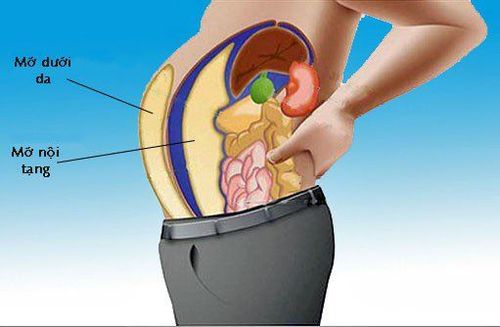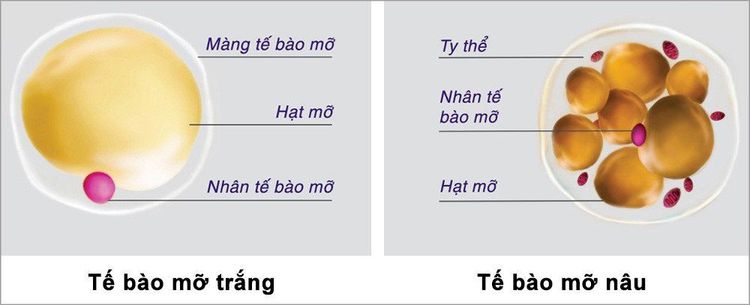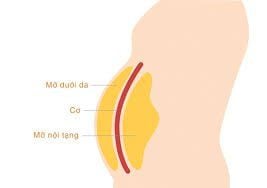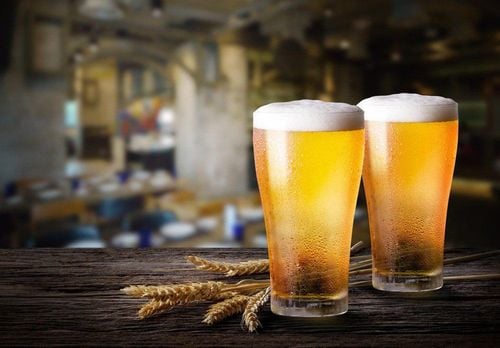This is an automatically translated article.
Fat is often associated with an ingredient harmful to health. However, it also brings many benefits to the body. It is important to control excess fat and weight to prevent disease and maximize the benefits of fat.
1. The role and classification of fat in the body
According to Dr. Susan Fried, director of the Center for Nutrition and Obesity Research at Boston University, fat helps store energy for use when hungry and releases hormones that control metabolism.
Fat is classified as follows:
Based on function, it is divided into brown fat and white fat. Based on the structure of fat layers, it is divided into subcutaneous fat and visceral fat. Based on the location of fat storage, it is divided into belly fat, thigh fat, buttock fat, neck fat, back fat, ... In this article, we only learn about belly fat, thigh fat and buttocks fat, which are the parts that contain fat. the most fat.

Hình ảnh mỡ nội tạng và mỡ dưới da
2. Brown fat
In recent studies, scientists have found that brown fat is more abundant in lean people than overweight and obese people and is used to burn calories. How brown fat gain or brown fat stimulation works are potential obesity treatments that need further study.
The more brown fat, the higher the body's ability to keep warm. Therefore, children are better able to keep warm than adults. Brown fat is more active in the cold months. This led to the idea that sleeping in a cold room has a calorie-burning effect, which helps with weight loss.
Brown fat is closer to the structure of muscle mass than white fat and has the effect of burning white fat when activated. Skinny people have more brown fat cells than white fat. A person weighing 68kg can have 9-14kg of fat, of which only 0.06 - 0.085kg of brown fat. If stimulating up to 0.06kg of brown fat can burn 300-500 calories per day, enough to lose 0.5kg of weight in a week. Researchers are trying to find a drug that increases brown fat.

Mỡ nâu có tác dụng giữ âm cơ thể
3. White fat
In the body, white fat is superior to brown fat. The function of white fat is to store energy and produce hormones that are then secreted into the bloodstream.
White fat cells help make a good hormone called adiponectin. This hormone works to make the liver and body more sensitive to the hormone insulin, reducing the risk of diabetes and heart disease.
When you are overweight or obese, the production of adiponectin slows down or stops completely, causing many people to develop diabetes and heart disease.
4. Subcutaneous fat
Subcutaneous fat is found directly under the skin. It is the amount of fat measured with skin-fold calipers, which are used to estimate total body fat.
In terms of overall health, subcutaneous fat in the thighs and buttocks is not harmful but offers several potential benefits. The cause of disease not only comes from visceral fat, but also comes from subcutaneous fat cells in the abdomen.

Mỡ dưới da nằm ở ngay dưới lớp da và trên lớp cơ
5. Visceral fat
A large waistline is a definitive sign of visceral fat. Compared to other types of fat, visceral fat is thought to be a major component that facilitates insulin resistance, which increases the risk of diabetes. In addition, it also contributes to cardiovascular disease, stroke, and even dementia.
According to research by Whitmer at the Kaiser Permanente healthcare center in Northern California, visceral fat is linked with dementia. People with the biggest bellies have a higher risk of dementia than those with smaller bellies. It holds true even for people with excess belly fat but a normal weight overall.
Scientists suspect leptin, a hormone secreted by belly fat, increases the risk of dementia in people with high belly fat. It regulates appetite, learning and memory.
6. Belly fat
Belly fat is unhealthy fat, both visceral and subcutaneous. The most accurate way to determine belly fat content is a CT scan. Women with a waist circumference greater than 90cm and men greater than 100cm have a higher risk of disease.
Belly fat is more harmful to health than hip or thigh fat. Especially increases insulin resistance, increases the risk of diabetes and worsens blood lipids, increases the risk of stroke and cardiovascular disease.
7. Thigh fat, butt fat
Thigh and buttock fat accumulates more in pear-shaped women. There is strong evidence that these people have a lower risk of metabolic diseases than people with large bellies. However, by menopause, when women tend to accumulate more belly fat, these benefits also decrease.

Mỡ đùi thường thấy ở những người thừa cân, béo phì
8. Weight loss and fat loss
When you are in the process of losing weight, you mainly lose white fat. If you exercise plus diet, you tend to lose some visceral fat from your belly. In the near future, scientists will discover more about fat and its application in weight loss.
Please dial HOTLINE for more information or register for an appointment HERE. Download MyVinmec app to make appointments faster and to manage your bookings easily.
Reference source: webmd.com












